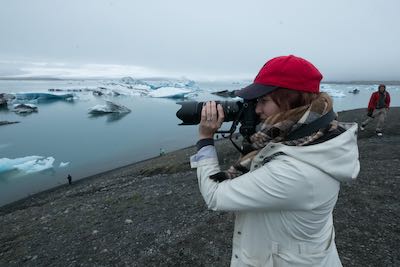
Steven Johnson is among the earliest of early adopters. When 360 video was in its infancy (all of two years ago) the photojournalist was among the first to experiment with a technology that puts viewers at the visual center of a story and lets them choose for themselves what to watch.
Since then, he’s shot 360 videos of Iceland’s melting glaciers and Panama’s vanishing coral reefs. He’s partnered on video stories with Reuters, the New York Times, ESPN, and Sports Illustrated; and founded a company, Boundless, that works with nonprofits, foundations, and news organizations to, as its website says, “share, educate, and change through storytelling.”
Given this cutting-edge experience, you might expect that Johnson, an instructor in Georgetown University’s Journalism graduate program, would have his students focus relentlessly on mastering the latest visual technology, but that’s not quite right.
In fact, they spend a fair amount of time, well, listening to the radio. Particularly to shows like NPR’s “This American Life” and “Morning Edition.”
“Radio does a very good job of putting you in a place where you can ‘see’ the story,” Johnson said.
It does this through a mix of words, sounds—and the listener’s imagination. Video uses a more direct route, moving pictures, while print and online publications allow readers to “see” the story through prose.
When the Medium Is Not the Message
Johnson’s point is this: If a piece of journalism “works,” it’s because of the skillful use of a given medium to tell the story, not any intrinsic magic in the medium itself. For this reason, he believes that 360 video—while a wonderful tool for involving viewers—will not, in itself, transform journalism. The story is still the point, which is why his class is called Immersive Storytelling Lab.
“We have got to get past the camera technology and focus on how we are strategically using this medium to help our audiences understand a story better,” Johnson wrote recently. “Otherwise journalism will miss the moving target of VR [virtual reality] just as we have been off our game in recognizing and taking full advantage of the internet, mobile, apps, and social.
“The time for experimentation is not over. We can still try new shooting techniques like drones and remote-controlled vehicles. But we should stop giving our audiences bad stories.”
“What’s This All About?” and Other Questions
So what’s the hardest part about making a story come alive with 360 video and related technologies?
“The hardest part about immersive storytelling and what I call ‘place-based’ journalism is where to put the camera,” Johnson said.
The answer might sound obvious (“you put it in front of the subject”), but it’s no more self-evident than the response a reporter might give—and often struggle with—when, after weeks of research and interviews, her editor asks: “What’s this story about?”
In fact, the answers to these questions are not obvious and involve a kind of conceptual and aesthetic thinking that should happen before any story is written or video is shot, Johnson said. For example, he described a recent 360 video on electric cars that filmed workers in an assembly line putting various parts on the vehicles. Unfortunately, it was boring, he said. Better would have been to put the camera on the car itself and film the story from the inside as this ground-breaking machine emerged.
An example of a “What’s-this-story-about?” question arose on a weeklong trip that Johnson’s class took to Iceland in June. Before the trip, each student was asked to make a proposal for a multimedia story involving prose, photos, and 360 video. Two topics were chosen, and the class split into groups to explore them over several intense days of work.
Watch the video Steven Johnson produced from the Georgetown Journalism Iceland trip.
One group focused on the members of Iceland’s small Muslim community, asking them what they liked about the small island nation, how their experience there had affected their faith, and how they got through the Ramadan fast on summer days that can last 22 hours.
The thematic issue arose with the second group, whose story was supposed to be on how Iceland’s shrinking glaciers—steadily melting from climate change—were troubling public officials and regular citizens alike. The problem was this: While Icelanders were obviously aware of these changes, interviews revealed that they were mostly focused on the practical aspects of adapting to them, such as planning kayak tours so that tourists could see glaciers they used to be able to reach on foot.
One student, Courtney Blackann, remembers sitting up until midnight with members of her group, asking: “OK, where can we take this? What’s the relevance of the story now?”
They decided to change their focus and look instead at the island’s harsh and changeable climate and how generations of Icelanders had learned to adjust to it. Certainly, there was a story there.
“They’re resilient people, and they’re not going to let the effect of climate change stop the tourism,” Blackann said. “The story became more about them, their resilience, their strength.”
